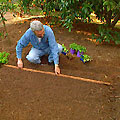In our segment Don talked about the value of animal manure in the garden. Manure conditions soils of all types, it provides nutrients, it is already more or less decomposed and it is teeming with bacteria and other beneficial organisms. Animal manures can either be dug into the soil, or they can be spread on the surface of the soil and used as a mulch. Some manure (for example poultry manure) is much stronger than others, and will smell quite strongly unless very well composted. It is important not to use fresh manure as it may burn plants – allow manures to age, collect old manure or store manure for several weeks before use on a garden. Most exotic plants, including citrus, roses, camellias and azaleas, benefit from applications of well-rotted manure, either dug in before planting or applied annually as a mulch. Take care when fertilising Australian native plants with manure: in most cases it is safer to use a low phosphorus or pelletised, slow release manure fertiliser. Manure can be purchased at nurseries, produce stores and hardware stores, but if you hunt around you can collect it for free or for just a few dollars from a nearby stable or farm.
Spring vegie garden
Don selected a sunny spot for his vegie growing. The site is well-drained and gets more than six hours direct sun a day. He prepared his spring vegetable garden by digging some well-rotted horse manure into the beds. He used a tomato stake laid on its side to mark out the drills (that is the straight rows where the vegie seedlings were to be planted) then put in a range of vegetable and herb seedlings including rocket, coriander, basil, several varieties of lettuce, Burke’s Backyard tomatoes and Burke’s Backyard Thai chillies. To work out the best spacing to allow between plants Don followed the information on the back of the plant label (also refer to vegie growing guides such as Yates Garden Guide – details below).
Birds
If you have birds, include some plants to feed to them to add variety to their diet. Some good food plants for birds include chickweed (usually considered a garden weed), amaranth (Amaranthus caudatus) and silver beet.
Don’s tips for growing vegetables
Vegetables need full sun and shelter from winds – a north-facing situation is best with at least six hours direct sun, including morning sun. Vegetables should be grown rapidly for best flavour – this is achieved with regular, usually daily watering, and regular applications of liquid food (every fortnight). Vegetables need a well-drained soil, with a loose, crumbly structure – digging well-rotted manure in to a spade’s depth before planting will improve the structure of any soil. Use additional fertiliser to encourage good growth – leaf vegetables need fertilisers which are high in nitrogen while fruit and root vegetables need a good supply of phosphorus. Spread your harvest – make repeated plantings (or sowings if growing from seed) every few weeks, also eat some vegetables when they are small and succulent, but leave others in the ground to develop further. Protect your vegetables from snails and slugs by using snail baits – but take care as snail baits are toxic to pets, especially dogs, and native animals (always scatter pellets so they are harder for dogs to find and eat, collect dead snails and dispose of in the bin so the poisoned snail can’t be eaten by another animal, and store snail bait packs well out of the reach of dogs). Other methods of snail control include collecting and squashing, and traps such as beer traps or barriers.
Further reading
‘Yates’ Garden Guide’ (2000, ISBN 0207191891, $27.44 paperback).



